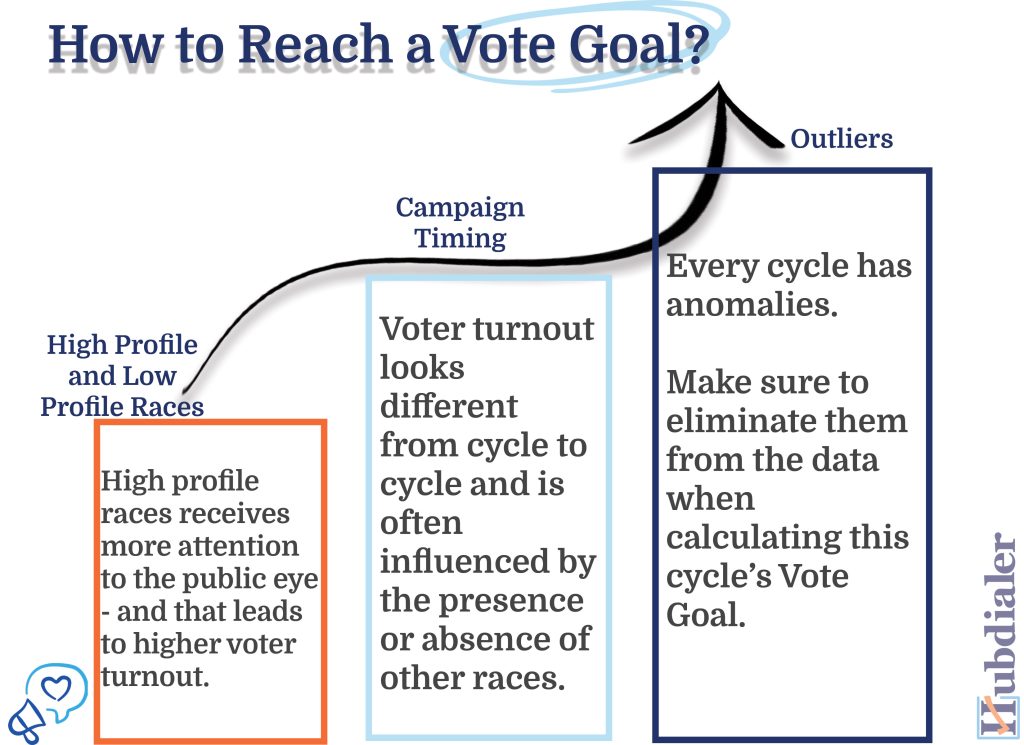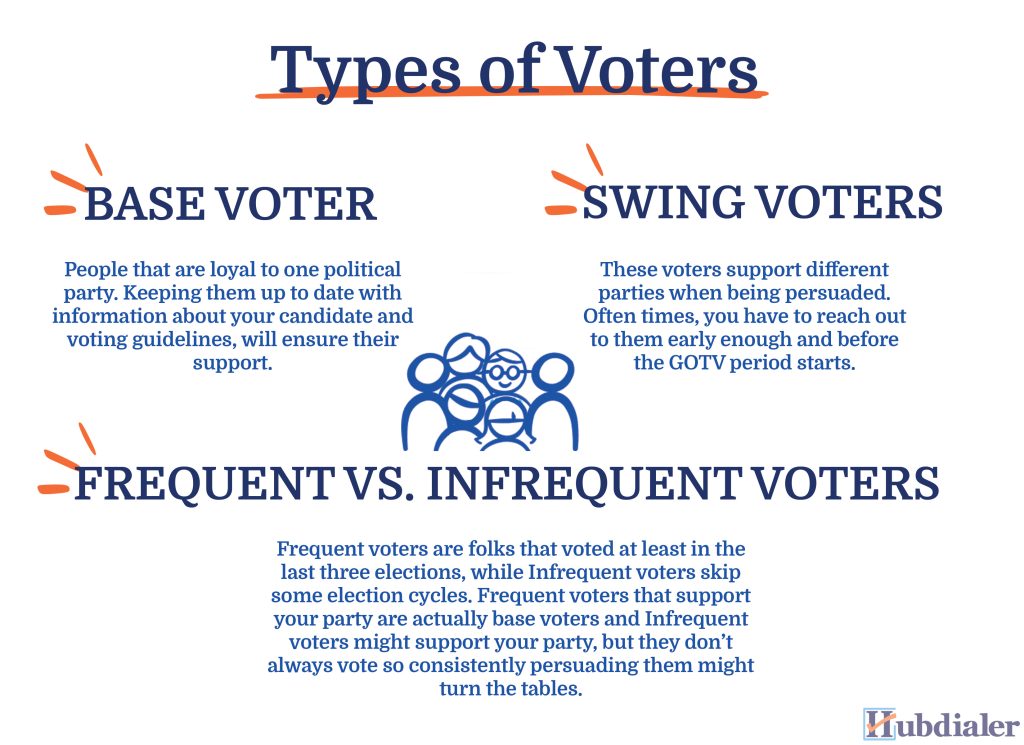Guides

Texting is now live! Learn more
Guides


Getting votes on election day is the end goal of any political campaign.
Voting is a crucial component of any political system – it allows citizens and people to decide who will lead their country and what direction it will take in the upcoming years. By casting a vote, individuals can elect officials who should, in theory, represent people’s interests and follow the political program presented during the campaign.
The right to vote means that citizens can directly impact the policies and laws that will affect their daily lives. Or, differently said, voting is a tool that gives ordinary people the power to influence the political process.
On the other side of the story, political officers and campaign staff fight for the votes. They want to present their programs and persuade many people to trust them. As a campaign manager, your job is to plan and execute many big and small activities and get enough votes to take over your desired function.
Your first task on that path is creating and laying out a basic political campaign plan. That plan needs to specify how many votes you need to win, defining your vote goal and how you plan to target your voters.
If you are at the beginning of your political race and unsure how to start, this guide will help you understand key elements and definitions for creating a solid vote plan.
A vote goal refers to the number of votes your campaign needs to receive on the voting day to win the race. It is the most critical number you must know before planning your campaign strategy and tactics.
Calculating the vote goal and voter turnout is a challenging task and it is always an estimate. As a campaign manager, you want to use the available information and data to estimate the vote goal that your team is confident about.
To reach the vote goal we estimated before, you need to get 50% of all votes plus one vote to win. However, your plan should always go after more than that and land around 55% of all votes. That way, if you get fewer votes than planned, you will still have a good chance of winning.
HubDialer’s predictive dialer makes your call campaigns simple and effective. Take it for a test drive with 500 free minutes and no setup fee or credit card required.

There are a couple of things you need to think about when planning your vote goal.
First, you want to look at the voter turnout from the previous elections. A good advice is to look at the numbers for the last two or three elections to see how much your office received.
Your vote goal depends on the type of race you are doing. For instance, down-ballot or lower-profile races (e.g., for city council) are typically less well-known because they appear further down the ballot. On the other hand, high-profile races typically receive more attention and are significant in the eyes of the public, such as the president, senate, or governor race.
So if your race is lower profile, you need to understand the previous voter turnouts and how they look for different districts.
Secondly, the timing of your campaign matters. Suppose your election happens in the same year as the big presidential elections. In that case, the voter turnout numbers will look different than if your election takes place in a year without significant political events.
As a result, if you want to calculate the average turnout rate for the last couple of elections, consider the last numbers based on the time the election took place and if significant political events influenced the previous turnout.
In short – if your local race takes place in the non-presidential year, use the voter turnout numbers from the last elections that also took place in the non-presidential year. And the opposite would be the case if your race happens in the presidential year.
Another consideration you need to take is outliers. If the previous elections showed an unusual result in, e.g., one part of the district, make sure to exclude those non-typical results.
So what would an example calculation look like? Look at the turnout rates from the last three elections and write down the highest. After that, calculate an average percentage number from these elections – that number will give you a solid estimate of how many people are likely to vote.
You want to check the number of currently registered voters in the following steps. E.g., If there are 10,000 people currently registered, and the average voter turnout rate from the previous three elections is 40%, you can expect around 4,000 people to vote on election day. Again, this is a rough estimate, and the more experience you have with previous vote goal planning, the more you can adjust your projections.
Finally, you need to calculate how many votes your candidate needs to get out of the projected turnout. Continuing with our example, if we know that 4,000 people are expected to vote, and we want to get at least 55% of votes, everything our campaign does will focus on getting 2,200 votes (55% of 4,000).
Be cautious if you think one of your previous turnout years had an unreasonably high or low turnout ratio. In those cases, you should adjust the projected turnout ratio for the next elections and, as a result, go after a higher or lower vote goal.

It is not possible to be 100% accurate about your projections. Remember that the final projection will depend on the number of candidates or if something significantly different can impact the election result. Using simple planning is better than not planning at all.
A good rule of thumb is to be more conservative when planning the votes – having a higher vote goal is better than setting your bar too low and realizing during the campaign that you will need more votes for the win. Better to have them and not need them than need them and not have them.
It would be best to start with the basics to collect the data that helps you calculate your vote goal. While there are different ballot race types, you will likely need to consider collecting the data at the district level.
The first step is to contact local election authorities and obtain publicly available data. Local authorities can provide a map of districts, streets, and precincts.
Each district consists of precincts that you can locate either from past election data or directly from the local authorities. Understanding how many precincts form a district will help you determine the expected turnout on the right level and help you plan your field strategy and activities.
A word of caution – a district can consist of split precincts, which means that a part of the precinct votes in a different district but for the same race. Just double-check the exact voting borders and precincts with the local authorities.
Also, sometimes district boundaries change between two election cycles, which, again, is something you need to check before calculating the turnout on a district level.
As we mentioned before, the starting point for your calculation will often be the last election data. Past data can shed light on typical voter turnout and voting behavior that doesn’t change dramatically between two elections.
If you want access to past data, they are available online or on demand from the local election authority. The local people can also answer your questions or help you understand the data.
Once you access data from previous elections, you will want to start crunching the numbers. In other words, you must do some basic calculations to work toward your vote goal.
To get a reasonable estimate of your vote goal, you will need to determine how many registered voters your target districts have, the estimated turnout, and your win number.
Let’s quickly look at how this could look in practice.
As mentioned before, you will want to use the data from at least the last three elections and use it to form your future estimations.
If you have access to the previous election data, you will be able to determine the following:
The next step you will want to work on is estimated voter turnout for the next elections. Again, many factors can influence your estimations:
If you expect the next race to be more competitive or that people strongly want to fight against a specific issue, you can increase your high turnout estimate.
Just remember – you are working on the estimates. The more previous data and district information you can collect, the more qualified you will be to make those estimates.
Now that we know our low vs. high voter turnout estimates, we can easily calculate our win number and vote goal.
The winning number you can calculate by dividing your estimated turnout by two and one more votes. However, while the winning number is theoretically enough to win the race, you will likely need to calculate with more votes to be safe.
For that reason, you need to determine your vote goal. Now that we have our low and high voter turnout estimates, we need to multiply these numbers with the percentage number that reflects better how many votes we will need.
We recommend using a number around 55% to develop a vote goal range and estimate the number of votes you will need.
Now that we explained the theory, we can look at the example that includes numbers.
Let’s go through the main terms again and add some numbers.
If this seems complicated, don’t worry. For a start, here is the table that you can use to track the past election data:
| Election year (pick last 3-5 elections for presidential or non-presidential year) | Number of total registered voters (add the number of registered voters for the election year) | Total number of votes (the total votes cast for the specific election) | Turnout Percentage (divide total votes with total registered voters) |
We can take those results and work on our vote goal calculation in another table. This table will expand later with the additional data.
| What | Value | Comment |
| Number of currently registered voters | Refers to the current number in your district | |
| Estimated turnout percentage low – high | Low range = last 3 electrons turnout divided by 3 High range = highest turnout for the last 3 elections | |
| Estimated voter turnout for the next election, low – high | Multiply low and high range with the number of currently registered voters | |
| Vote goal, low – high | Multiply estimated voter turnout for the next election with you vote goal, such as 55% |
Now that we know how many votes we need to win in our district, let’s learn more about the types of voters we will need to target to reach our vote goal.
After defining your voter turnout estimates, vote goal, and additional assumptions important for your race, you should start thinking about the types of voters that will contribute to your vote goal.
If possible, please create an image that somehow connects these three types of voters that I mention in this chapter. Or a chart with brief explanation of each of those voter types and icons.

One of the terms you often hear when discussing voter types is base voters. Base voters, or party voters, are loyal to one political party and regularly vote for it.
You can identify base voters by looking at the voter file, which contains information about previous voting activity, including the voter’s name, address, and voting history.
The voters that always vote for the same party, that is, they always vote in specific party primaries (either Democratic or Republican), are most likely base voters.
Having a good percentage of base voters in your geographical area is essential because your base voters always support your party.
Because of that, your goal with base voters is to keep them updated with general information about your candidate and ensure that they know how and when to vote; e.g., by sharing the information during the get out the vote (GOTV) period.
Other types of voters are swing voters or persuasion voters. They aren’t loyal like base voters but support different parties when persuaded.
Sometimes you will need to focus your energy on persuading the swing voters, especially if you don’t have enough base voters in your target region or district. And to be successful with your persuasion efforts, you often have to reach out to swing voters early enough and before the GOTV period starts.
Other types of voters that can contribute to your vote goal are frequent and infrequent voters. Frequent voters are folks that voted at least in the last three elections, while infrequent voters skip some election cycles.
It is worth noting that both frequent and infrequent voters can be good and bad for your campaign. If someone is a frequent voter but doesn’t support your party, you most likely won’t be able to persuade that person to change his or her mind. And frequent voters that support your party are base voters, the people you already have on your side.
Infrequent voters might support your party, but they don’t always vote. Therefore, you need to identify those correctly and encourage them to vote when election day comes.
To sum up, all this together – every person who votes can be either a base or swing voter, frequent or infrequent. When planning your campaign, you want to know how many people are frequent voters for one very crucial reason – to understand your voter deficit.
Voter deficit is the number you get after subtracting frequent base voters from the vote goal. In other words, if your vote goal is higher than all frequent base voters in a district, you must focus your campaign on identifying and persuading the rest of the people to vote for you.
So what kind of votes are those that you need to persuade? Well, they can be infrequent base voters, which should be the easiest to persuade to vote. Or, they can be frequent and infrequent swing voters, which will take most of your persuading time.
Understanding the voter types in your district and estimating your voter deficit is vital when planning your campaign.
Planning your political campaign without vote planning is a recipe for defeat.
By thinking about your vote goal, vote deficit, win number, and the types of voters, you are building the critical assumptions that influence the operational part of your campaign.
Vote planning will determine almost everything – your budget, resources, volunteer needs, field activities, marketing, and everything else. Make sure to give it enough attention in advance.
And when your campaign progresses to field operations and calling campaigns, head over to HubDialer’s sign-up page and claim your 500 free calling minutes. That way, you can start talking to your current and potential voters whenever you like.